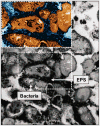Advances in the microbial etiology and pathogenesis of early childhood caries
- PMID: 26714612
- PMCID: PMC4929038
- DOI: 10.1111/omi.12152
Advances in the microbial etiology and pathogenesis of early childhood caries
Abstract
Early childhood caries (ECC) is one of the most prevalent infectious diseases affecting children worldwide. ECC is an aggressive form of dental caries, which, left untreated, can result in rapid and extensive cavitation in teeth (rampant caries) that is painful and costly to treat. Furthermore, it affects mostly children from impoverished backgrounds, and so constitutes a major challenge in public health. The disease is a prime example of the consequences arising from complex, dynamic interactions between microorganisms, host, and diet, leading to the establishment of highly pathogenic (cariogenic) biofilms. To date, there are no effective methods to identify those at risk of developing ECC or to control the disease in affected children. Recent advances in deep-sequencing technologies, novel imaging methods, and (meta)proteomics-metabolomics approaches provide an unparalleled potential to reveal new insights to illuminate our current understanding about the etiology and pathogenesis of the disease. In this concise review, we provide a broader perspective about the etiology and pathogenesis of ECC based on previous and current knowledge on biofilm matrix, microbial diversity, and host-microbe interactions, which could have direct implications for developing new approaches for improved risk assessment and prevention of this devastating and costly childhood health condition.
Keywords: Candida; Streptococcus; biofilm; dental caries; diet; matrix; microbiome; saliva.
© 2015 John Wiley & Sons A/S. Published by John Wiley & Sons Ltd.
Conflict of interest statement
The authors declare no conflicts of interest with respect to the authorship and/or publication of this article.
References
-
- Belda-Ferre P, Williamson J, Simón-Soro Á, Artacho A, Jensen ON, Mira A. The human oral metaproteome reveals potential biomarkers for caries disease. Proteomics. 2015;15:3497–3507. - PubMed
-
- Berkowitz RJ, Turner J, Hughes C. Microbial characteristics of the human dental caries associated with prolonged bottle-feeding. Arch Oral Biol. 1984;29:949–951. - PubMed
Publication types
MeSH terms
Grants and funding
LinkOut - more resources
Full Text Sources
Other Literature Sources
Medical



